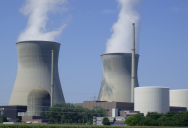China Successfully Performs Full Cooling Failure Test On New ‘Meltdown Proof’ Nuclear Reactor

Nuclear energy is one of the most controversial options for producing electricity. On the one hand, nuclear power plants can generate a huge amount of electricity without emitting greenhouse gasses.
On the other hand, when a disaster strikes, the potential for an explosion or radiation impacting the surrounding area is quite high.
The biggest risk to most nuclear power plants is that the cooling system goes offline for some reason, which causes the fuel rods to begin to heat up rapidly.
This continues until a meltdown occurs, which can have devastating consequences.
For water cooled facilities, this could mean that the water molecules break apart into explosive hydrogen and oxygen. For other cooling options, the result might not be an explosion, but it can still cause widespread damage.

Of course, nuclear power plants are built with multiple levels of cooling redundancy to help reduce the risk of a meltdown, but it is impossible to eliminate the risk of a a cooling failure entirely.
With that in mind, experts have been working on nuclear power plant designs that do not experience runaway heat production even when the cooling systems fail.
Rather than using large fuel rods, this design uses small fuel pebbles. With a large number of these pebbles, each containing small amounts of uranium, it is possible to avoid meltdowns entirely.
This method is known as a pebble-bed reactor (PBR).
This design can be cooled using similar methods as traditional nuclear reactors. The difference, however, is that if the cooling systems are lost, the fuel pebbles will simply cool themselves over time once they stop producing electricity.
China recently built the first full-scale pebble-bed reactor, and so far it is functioning very well.
Once the facility was fully operational, they performed tests to ensure the system worked effectively, even when there was a complete loss of cooling.
The team working on this reactor released information about these tests, saying:
“To confirm the presence of inherent safe reactors on a commercial scale, two natural cooling tests were performed on the #1 reactor module on August 13, 2023 and the #2 reactor module on September 1, 2023. During the entirety of the tests, the reactor modules were naturally cooled down without emergency core cooling systems or any cooling system driven by power.”

The tests essentially turned off all cooling, which triggered the system to disengage the fuel pebbles so they stopped producing energy. From there, the heat simply dissipated naturally over time.
It took about 35 hours for them to cool down completely.
This is a stark contrast to existing fuel rod systems, which would have likely continued to get hotter until a full or partial meltdown occurred.
This new ‘meltdown proof’ nuclear reactor design makes nuclear energy safer than ever.
If you thought that was interesting, you might like to read about why we should be worried about the leak in the bottom of the ocean.

Sign up to get our BEST stories of the week straight to your inbox.




